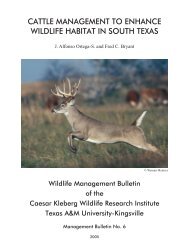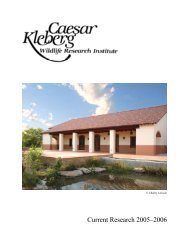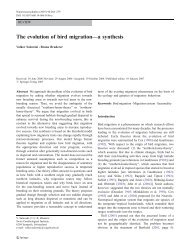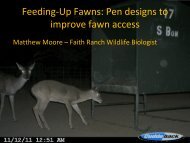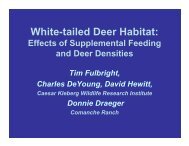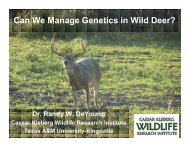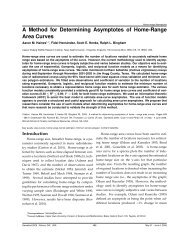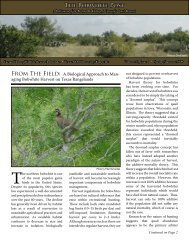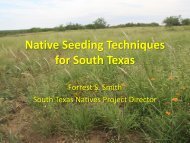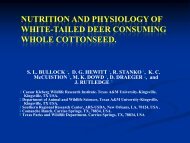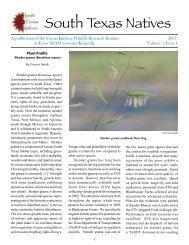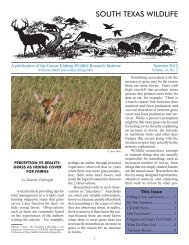The Northern Yellowstone Elk: Density Dependence and Climatic ...
The Northern Yellowstone Elk: Density Dependence and Climatic ...
The Northern Yellowstone Elk: Density Dependence and Climatic ...
Create successful ePaper yourself
Turn your PDF publications into a flip-book with our unique Google optimized e-Paper software.
J. Wildl. Manage. 66(1):2002DENSITY DEPENDENCE IN YELLOWSTONE ELK * Taper <strong>and</strong> Gogan 109Table 2. Late winter age <strong>and</strong> sex composition of the northern<strong>Yellowstone</strong>lk herd, winters 1987-1988 through 1995-1996,Montana <strong>and</strong> Wyoming. Data are from records archived at <strong>Yellowstone</strong>National Park, Mammoth, Wyoming, USA.Calves: Yearling M: Adult M:Year 100 F 100 F 100 F n1987-1988 23 4 15 5,1031988-1989 6 2 13 2,8271989-1990 19 3 12 3,3931990-1991 26 - - 1,9251991-1992 44 - - 3,5301994-1995 33 11 29 3,6131995-1996 28 9 26 2,902of elk numbers for winters 1986-1987 through1990-1991 by adjusting numbers to account forthe proportion of radiocollared elk that were notseen during the st<strong>and</strong>ard aerial censuses.Coughenour <strong>and</strong> Singer's (1996) calculationsindicate that even in good survey years, aerialcensuses post-1986-1987 underestimate the populationlevels on the order of 25%. However, forthe 1988-1989 <strong>and</strong> 1990-1991 censusesCoughenour <strong>and</strong> Singer (1996) believe that only49 <strong>and</strong> 51% of the population was counted,respectively, confirming the census participants'assessments. We reduced the Coughenour <strong>and</strong>Singer (1996:574) corrected estimates for1988-1989 <strong>and</strong> 1990-1991 by 25% to make themcomparable with the rest of the count data.Early <strong>and</strong> Late Periods<strong>The</strong> census data do not form a continuousrecord. No population estimates were made during1980, 1981, 1983, or 1984. Consequently,growth rates are not available from 1979 to 1984.This divides the time series into an early (i.e.,1964-1979) <strong>and</strong> a late (i.e., 1986-1995) period.Adjusting for HuntingBecause our intent was to investigate the naturalregulation of the northern <strong>Yellowstone</strong> elkherd, we corrected for hunting to discern theunderlying natural population dynamics regardlessof whether hunting is density-dependent ordensity-independent. <strong>The</strong> annual elk cycle in <strong>Yellowstone</strong>begins with calving in spring, resultingin a population increase (Fig. 1). Perinatal mortalityreduces the population size somewhat(Singer et al. 1997), <strong>and</strong> then the populationenters a period with comparatively low naturalmortality until late winter (Green et al. 1997).Superimposed on this cycle are annual total herdcounts at the beginning of each year <strong>and</strong> annualhunting mortality. This population is subjectedto a regular-season hunt <strong>and</strong> a late-season hunt.<strong>The</strong> regular hunt has occurred between lateOctober <strong>and</strong> late November since the mid-1960s(Erickson 1981). <strong>The</strong> late hunts have varied fromlate November through early March during themid-1960s, mid-December through mid-Februaryduring the early 1980s, <strong>and</strong> earlyJanuary to mid-February during the 1990s (Erickson 1981,Lemke et al. 1998). Thus, the count <strong>and</strong> mosthunt mortality occur during a period of low naturalmortality. This allows us to study densitydependence in this herd as it would haveoccurred in the absence of hunting. We calculatea pre-hunt population estimate by adding all legalharvest plus known illegal kills <strong>and</strong> lost woundedanimals presumed to have died that occurredbefore the annual count to the estimated herdsize (Lemke et al. 1998). In a similar fashion, apost-hunt population estimate is constructed bysubtracting known subsequent anthropogenicmortality from the census (Table 1). We investigatednatural population regulation by studyingthe statistical dependence of transitions in populationnumbers from post-hunt to pre-hunt thenext year on post-hunt population size.Correcting for Range Expansion<strong>Density</strong> dependence by definition relatesgrowth rates to population densities. Calcula-tions based on raw population counts will not bevalid if range expansions or contractions occur.<strong>The</strong> winter range for the northern <strong>Yellowstone</strong>elk herd increased during the early 1980sPre-huntestimatez Z I /_ \6iPerinatal mortalityAerialcount Post-huntestimateCalving Early Latehunt huntWinter mortalityMay Jul Sep Nov Jan Mar MayJun Aug Oct Dec Feb AprFig. 1. Schematic diagram of annual cycle of elk numbers, timingof natural <strong>and</strong> human-induced mortality <strong>and</strong> sampling,northern <strong>Yellowstone</strong>lk herd, Montana <strong>and</strong> Wyoming.



